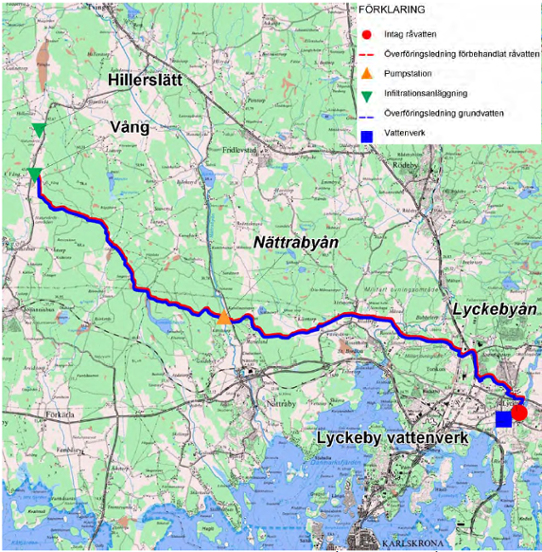The drinking water in Karlskrona is taken from the river Lyckebyån, which is a long watercourse with an erratic water quality. When there is heavy rain, the water is coloured brown by small organic particles and in the summer the water reaches temperatures close to 20°C. The brown river water is problematic to purify and requires an extensive process involving chemicals. In the summer, consumers do not have access to cold tap water as the water is only cooled marginally on its way through pipes and purification processes.
Climate change will warm the water further in the summer and heavier rain risks transporting more pollutants down the river. Higher temperatures also lead to the microbiological risks increasing.
Johannishusåsen
In 1994, an accident occurred that polluted the drinking water source in a nearby municipality. If a similar accident were to pollute Lyckebyån, Karlskrona would be without a functioning drinking water supply as there is no reserve water source. The Johannishusåsen project was initiated in order to deal with the risk of being without a drinking water supply and to improve the water quality.

This project involves creating artificial groundwater by pumping water from Lyckebyån into the gravel esker Johannishusåsen. The river water will first be pre-treated in Karlskrona’s waterworks before being pumped twenty kilometres to the esker where the water will infiltrate down through ponds. A natural purification process takes place in the esker that purifies and complements the treatment in the waterworks.
Just over fourteen days after the water has infiltrated down into the esker, it is pumped up as artificial groundwater in a well further away from the esker. On the way to the esker, the water pipeline passes the river Nättrabyån, which provides the opportunity to take reserve water should a serious pollution incident occur in Lyckebyån. The map below to the right shows how the water is transported to and from Johannishusåsen.
Johannishusåsen came into full operation in June 2015, which means that consumers now have secure access to drinking water of a higher and more consistent quality. In summer, there will be cold water at the same time as the esker filters out microorganisms and small organic particles, reducing the need for chemicals.
Work is under way to create a water protection area. The goal is the long-term protection of the water supply in a perspective that stretches for many generations.
Financing
The project is estimated to have cost around SEK 375 million. SEK 150 million is being used to adapt the purification works to the pre-treatment of the water before it is sent to the esker and the final treatment of the artificial groundwater. In terms of the other costs of the project, the most expensive have been the pipelines with a cost of SEK 135 million. The remaining costs are new buildings, the infiltration ponds, investigations and legal processes. The operating and capital costs of the project will be around SEK 20 million per year.
The map shows the route the water takes to and from Johannishusåsen. The water intake in Lyckebyån (red circle) takes in raw water and pre-treats it before it is pumped to the esker in the red pipeline. There is a pumping station (orange triangle) by Nättrabyån that can take reserve water to the esker. The infiltration ponds on the esker are marked with green triangles. When the infiltrated water is then pumped up as groundwater, it is transported to the purification works (blue square) in the blue pipeline for final treatment.
More examples of climate adaptation
This is one of many examples of climate adaptation. There are more in the collection of ideas being built up by the Swedish National Knowledge Centre for Climate Change Adaptation at the Swedish Meteorological and Hydrological Institute (SMHI). The collection of examples has the aim of sharing experiences and providing ideas to everyone who works with climate adaptation. Examples describe concrete measures and challenges in several subject areas. They show how different actors have worked to adapt their activities to the climate changes that are already being noticed today and those that we cannot prevent in the future.